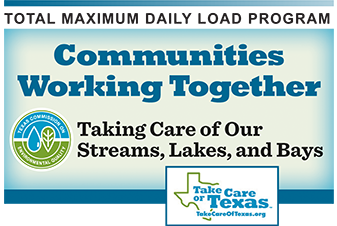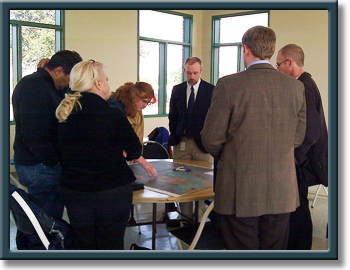Projects
Description
Austin Watersheds
A project to improve water quality and protect recreational uses in watersheds of Austin, Texas.
Pictures of various creeks in the project to protect recreational uses of Austin watersheds
The Austin Area Watersheds Implementation Plan (I-Plan) Stakeholder Group formed in June 2021 to update the total maximum daily loads (TMDLs) I-Plan for bacteria in Austin-area streams for a second five-year period through 2027. The I-Plan and the TMDLs together provide the road map for improving water quality in the affected streams.
On this page are data, maps, and other resources for stakeholder use in updating the Austin Streams I-Plan for total maximum daily loads (TMDLs) to reduce bacteria levels in affected water bodies.
Carancahua Bay
A project to reduce bacteria and protect recreational safety in Carancahua Bay.
This is a project to reduce bacteria and protect recreational safety in Carancahua Bay. The stakeholders and TCEQ developed a total maximum daily load (TMDL) and implementation plan (I-Plan), which together are the road map for improving water quality. The TMDL was adopted and the I-Plan has been approved.
Carters Creek
A project to improve water quality and protect recreational uses by reducing bacteria concentrations.
There are currently no items in this folder.
Chocolate Bayou
A project to reduce bacteria and protect recreational safety in Chocolate Bayou
This is a project to reduce bacteria and protect recreational safety in Chocolate Bayou. The stakeholders and TCEQ have developed total maximum daily loads (TMDLs) and are developing an implementation plan (I-Plan), which together will be the road map for improving water quality.
Colorado River Below E.V. Spence Reservoir
This is a project to implement TMDLs that reduce salinity from chloride, sulfate, and dissolved solids. The TMDLs have been adopted. The I-Plan is complete.
Completed Projects of the TMDL Program
All completed TMDL program projects and assessments, listed in alphabetical order by project name.

Related pages:
Gilleland Creek Bacteria
The goal of this project is to make recreation safe in Gilleland Creek by reducing bacteria. The adopted TMDL and the approved I-Plan combined are the road map to improving water quality in the creek.
Guadalupe River Above Canyon
A project to improve water quality and protect recreational uses by reducing bacteria concentrations in the river segment.
Houston Bacteria
The goal of this project is reduce bacteria levels and protect recreational safety in waterways of the metropolitan area. The stakeholders and TCEQ developed total maximum daily loads (TMDLs) and an implementation plan (I-Plan), which together are the road map to improving water quality.
Lake Pines Oxygen
The goal of this current project is to improve conditions for fish and other aquatic life by increasing the levels of dissolved oxygen in the lake. Combined, the adopted TMDL and the approved I-Plan are the road map to improving water quality in the lake.
What's going on and what's been done to improve conditions for aquatic life in Lake O' the Pines.
Videos, news, and photos about the plan to improve conditions for aquatic life in Lake O' the Pines
The TMDL and its I-Plan are the road maps for activities to improve conditions for aquatic life in the lake.
Photos of meetings to work on improving conditions for aquatic life in Lake O' the Pines.
Photos of meetings to work on improving conditions for aquatic life in Lake O' the Pines.
Photos of meetings to work on improving conditions for aquatic life in Lake O' the Pines.
Photos of meetings to work on improving conditions for aquatic life in Lake O' the Pines.
Photos of meetings to work on improving conditions for aquatic life in Lake O' the Pines.
This is a community project to improve conditions for aquatic life by increasing dissolved oxygen levels in the Lake O' the Pines. Together, the adopted total maximum daily loads (TMDLs) and approved implementation plan (I-Plan) are the road map to improved water quality.
Lavaca River and Rocky Creek
A project to reduce bacteria and protect recreational safety in the Lavaca River Above Tidal and Rocky Creek.
Navasota River
A community project to reduce bacteria and improve water quality in the Navasota River.
Participating in TMDL Projects
How people and communities can work together to protect their streams, lakes, and bays by getting involved in developing TMDLs and their implementation plans
Petronila Creek
A project to implement TMDLs that reduce salinity from chloride, sulfate, and dissolved solids in Petronila Creek. The TMDLs are adopted. The I-Plan is complete.
Projects of the TMDL Program
The Total Maximum Daily Load Program is communities working together on projects to improve water quality in the streams, lakes, and bays of Texas by reducing pollution.
The TMDL Program works with communities around the state to restore Texas waterways that have limited quality in relation to one or more of their assigned uses, such as recreation, fishing, or a healthy aquatic environment. The latest Index of All Water Quality Impairments, part of the Texas Integrated Report of Surface Water Quality, shows all impaired waterways and the strategies that are planned or under way to improve their quality.
In addition to working with stakeholders to develop and implement TMDLs, the program manages studies that determine the best management strategies for specific waterways.
Learn more about TMDLs and How They Are Implemented.
Read about what it means to participate in TMDL projects.
TMDLs and I-Plans
- TMDLs or I-Plans in Development are listed in alphabetical order by waterway or region name. This includes projects for which TMDLs have been adopted but I-Plans are still in development.
- Completed projects and assessments are listed here in alphabetical order by waterway or region name.
 TMDL Summary Table: Download this spreadsheet for a list of all TMDL assessment units, approval/adoption dates and project webpages. (last updated August 2025).
TMDL Summary Table: Download this spreadsheet for a list of all TMDL assessment units, approval/adoption dates and project webpages. (last updated August 2025).
Contact the TMDL Program
Please email tmdl@tceq.texas.gov or call 512-239-6682. Sign up to get News Updates from the TMDL Program to be notified when TMDLs or I-Plans are in public comment, along with notices of adoptions and approvals and other water quality news.

TMDLs or I-Plans in Development
Below is a list of current projects to develop total maximum daily loads (TMDLs) or implementation plans (I-Plans), which together are a road map for improving water quality.
Tres Palacios Creek
A project to improve water quality and protect recreational uses of Tres Palacios Creek.
Arenosa Creek
This is a project to reduce bacteria and protect recreational safety in Arenosa Creek. The stakeholders and TCEQ developed a total maximum daily load (TMDL) and implementation plan (I-Plan), which together provide the road map for improving water quality in the creek. The TMDL is adopted and the I-Plan is approved.
Oyster Creek: Bacteria
This is a project to reduce bacteria and protect recreational safety in Oyster Creek. The stakeholders and TCEQ developed a total maximum daily load (TMDL) and an implementation plan (I-Plan), which together are the road map for improving water quality.

 Back to TMDL Projects
Back to TMDL Projects









 Back to top
Back to top